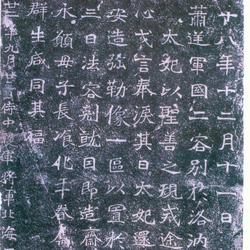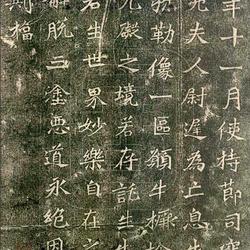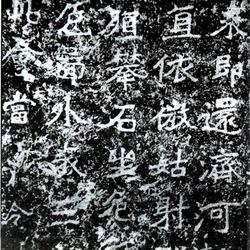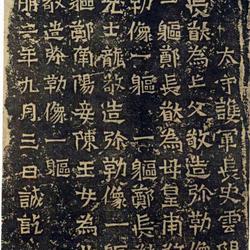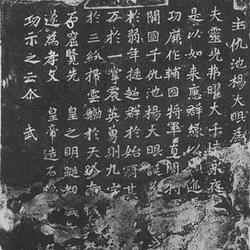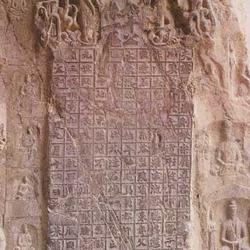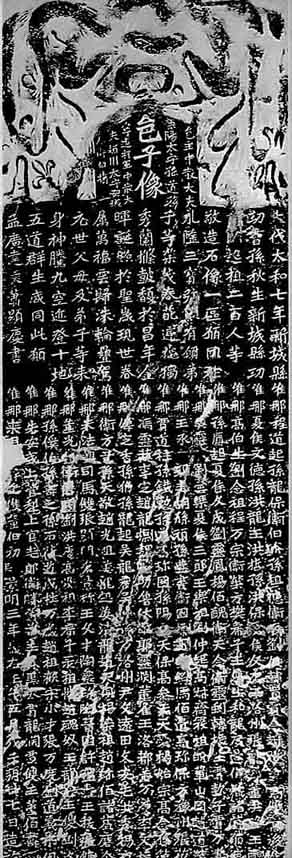
"The Statue of Sun Qiusheng", the full name of "The Statue of Sun Qiusheng, Liu Qizu and Two Hundred Others", is on the south wall of Guyang Cave of Longmen Grottoes in Luoyang. It was completed on May 27th in the third year of Jingming Dynasty (502) by Emperor Xuanwu (Yuan Keke) of the Northern Wei Dynasty. The calligraphy on this stele is sharp and vigorous, broad and simple, and its writing style is more varied than that of "The Statue of Shi Ping Gong". It is one of the twenty works of Longmen. Written by Meng Guangda and written by Xiao Xianqing. There are fifteen lines in regular script and thirty-nine characters in each line. The font is square and vigorous, calm and vigorous. The brushwork is concise and free.
[Exchange items]
Qing Dynasty Kang Youwei: After Taihe, various schools of thought emerged, and Zhuang Mao wrote "Sun Qiusheng" ("Guangyi Zhou Shuangji")
Kang Youwei of the Qing Dynasty: Among the twenty pieces of Longmen, they are roughly divided into several styles. "Sun Qiusheng" is composed of calm, vigorous and heavy.
other information
The statue niche is located on the second floor of the ancient Yangbi. The statue niche of Bhikkhu Fasheng is adjacent to the left side and was built by Sun Qiusheng, Liu Qizu and other two hundred people from Xincheng County. The statue niche is 254 cm high, 154 cm wide and 60 cm deep. It is one of the five major niches among the twenty-grade statue niches. The four dragon-pointed arches are in the shape of a round coupon. There is a flying sky on the lintel of the niche and eleven Buddhas below. The two upright columns are eight-sided plain surfaces with lotus petal-shaped capitals and are supported by strong men below. The main Buddha sits cross-legged, with fine backlight carvings and rich content. The center of the headlight is a lotus, surrounded by thirteen seated Buddhas on the outer layer, and twelve flying bodies on the outer layer to offer treasures. The blazing flame pattern outside Feitian is backlit to the top of the niche. On the right side of the Buddha is Avalokitesvara, and on the left side are the two Bodhisattva Mahasthamaprapta serving. In the middle under the niche is an incense burner surrounded by two dragons. On both sides are carved figures of donors kneeling in worship, and on the left and right sides of the outer end are two lions.
Gong Cao was an official position established in the Han Dynasty. In the Northern Wei Dynasty, it was one of the Cao Cao in the General's Office. This official was mostly held by local powerful people and ranked between the sixth and ninth ranks. Zhongsan Dafu was an additional official to the civil servants. In the 17th year of Taihe, Emperor Xiaowen of the Northern Wei Dynasty, he was designated as the fourth rank (upper rank), and in the 23rd year of Emperor Xiaowen of the Northern Wei Dynasty, he was ranked fourth rank (lower rank).
The seat of Xincheng County recorded in the monument is Gucheng Village, Pingping Township, 5 kilometers south of Yichuan County, Henan Province today. During the Warring States Period, it belonged to Korea, and Xincheng County was under the jurisdiction of Xincheng County. Longmen was called "Yiqian". The Western Han Dynasty belonged to Henan County. In the Eastern Han Dynasty, the Three Kingdoms belonged to Henan and Yi. The Western Jin Dynasty restored Henan County. During the reign of Emperor Xiaowen of the Northern Wei Dynasty, Yixing was changed to "Yixingkou", and it was under the jurisdiction of Sizhou together with Xincheng County. The Sui Dynasty established its capital in Luoyang, and Emperor Wen changed Xincheng County to "Yiqian County" and returned it to Henan County. The Tang Dynasty was transferred to the jurisdiction of Henan Prefecture.
During the Warring States Period, Qin general Bai Qi set out from Hancheng and garrisoned in Xincheng County. He went north to "Yi Qian" and defeated the 240,000 allied troops of Han and Wei. This was an unprecedented "Yi Qian" battle in history. Xincheng County is an important town in Chinese history. In the Song Dynasty, Xincheng County was changed to "Yiqian Town" and came under the jurisdiction of Luhun County. Yixiankou was named Longmen Town. In the Yuan Dynasty, the city was abandoned and the establishment of Yixian County ceased to exist. The city wall is still intact. Because local people say that in the late Warring States period, the princes were fighting and the princes were in chaos. King Zhou Hao once took refuge here, so it is still called "Hao King's City" to this day.
Sun Qiusheng and Liu Qizu were only meritorious officials in Xincheng County in the Northern Wei Dynasty, and their official positions were not high. When Emperor Xiaowen moved the capital to Luoyang, they were able to organize 200 people, including ministerial officials of the fourth rank, to create statues and pray for "the country". "Zuo Yonglong, the Three Treasures Mi Xian" expresses their loyalty to the Northern Wei Dynasty, which shows that they must be local powerful people. The stele is 153 centimeters high and 50 centimeters wide. The inscription was written by Meng Guangda and written by Xiao Xianqing. This stele and the inscription on the statue of Duke Shi Ping are the only two inscriptions among the twenty items in Longmen that have the author and inscription.

